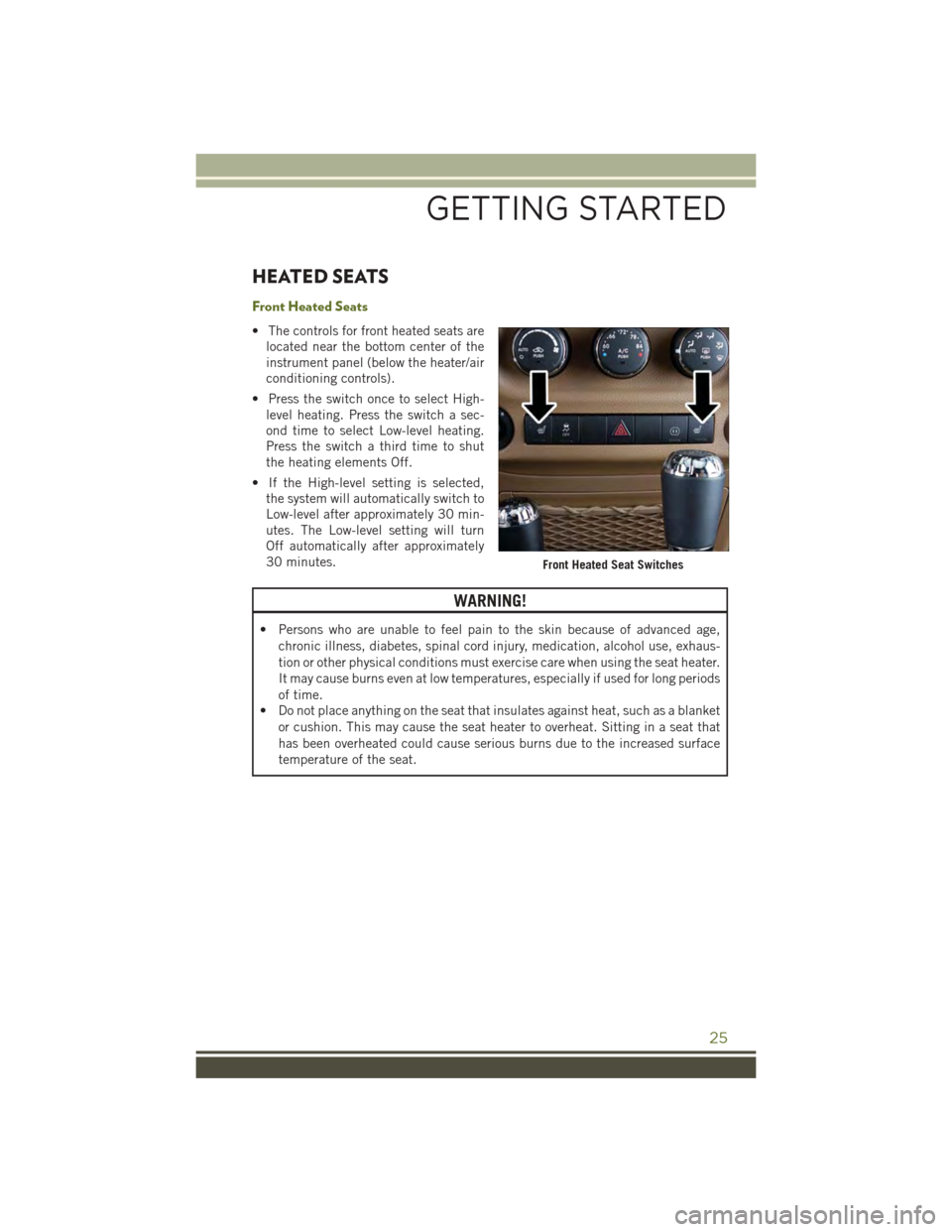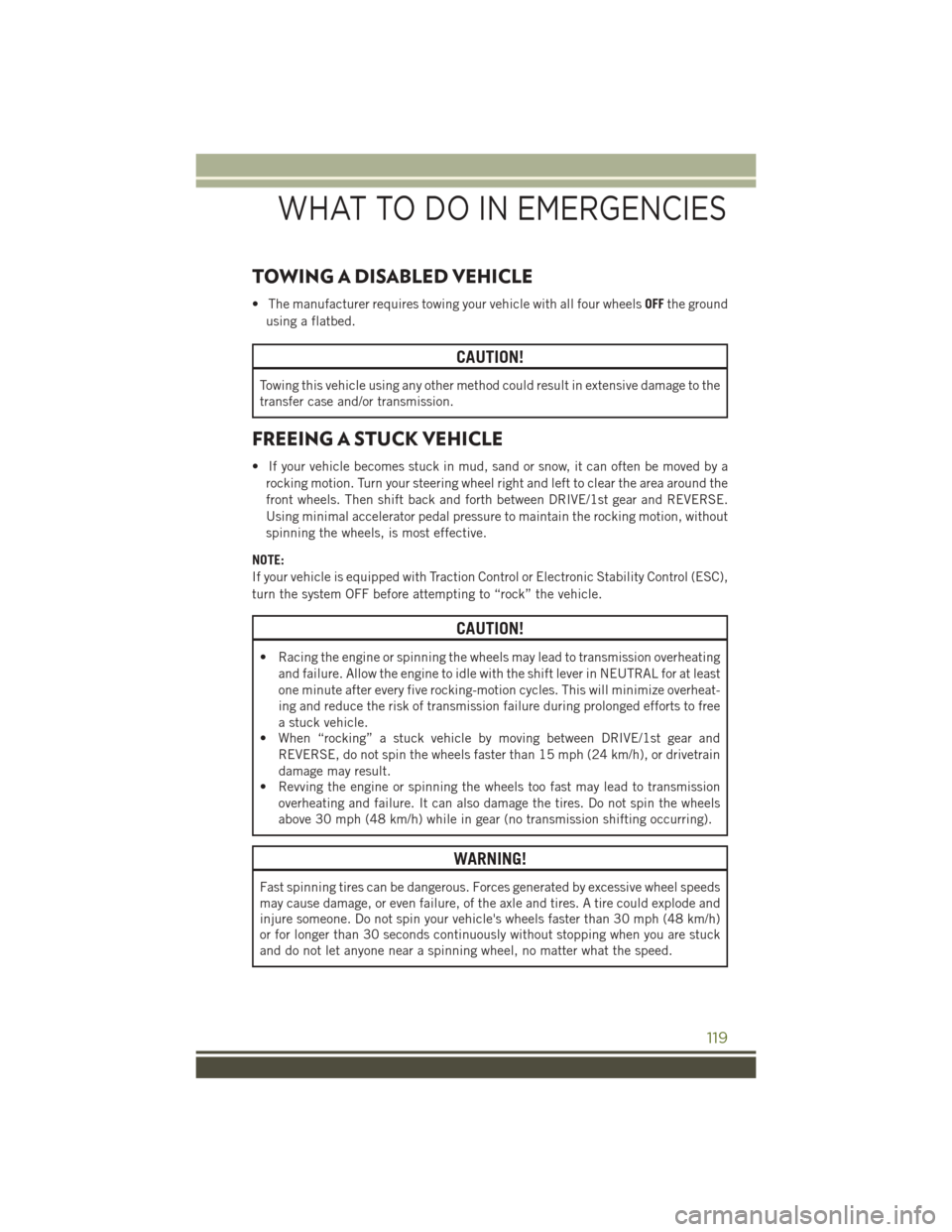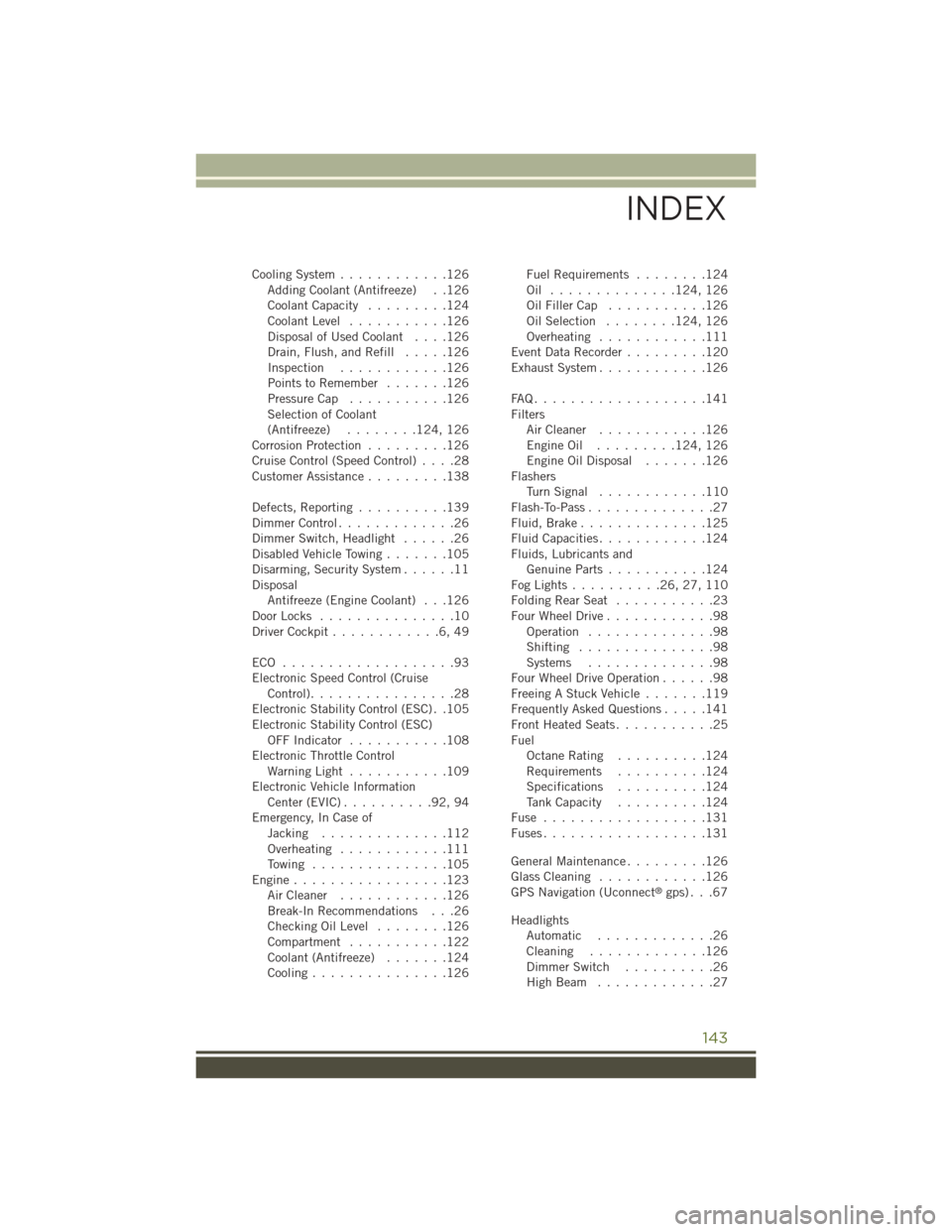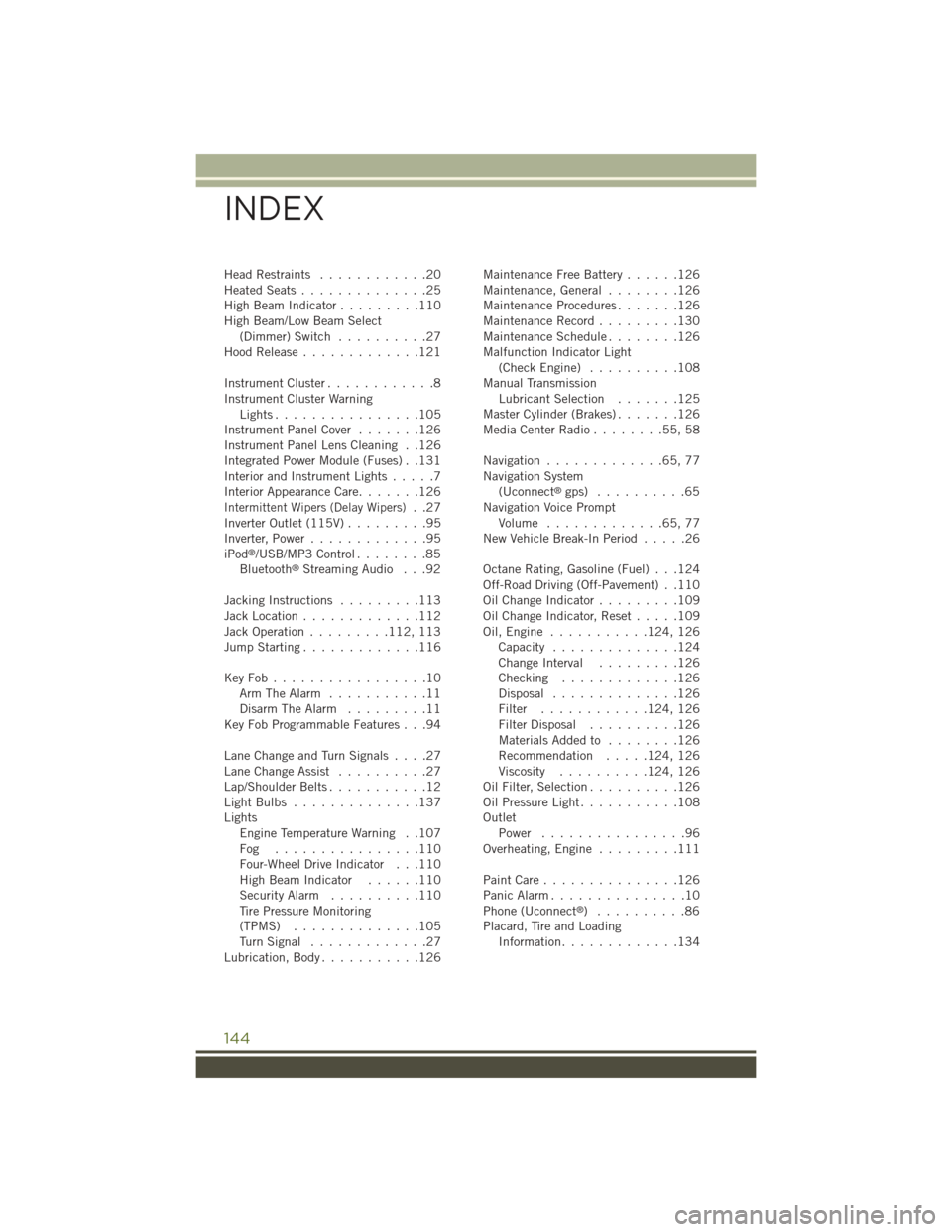heating JEEP WRANGLER 2015 JK / 3.G User Guide
[x] Cancel search | Manufacturer: JEEP, Model Year: 2015, Model line: WRANGLER, Model: JEEP WRANGLER 2015 JK / 3.GPages: 156, PDF Size: 23.54 MB
Page 27 of 156

HEATED SEATS
Front Heated Seats
• The controls for front heated seats are
located near the bottom center of the
instrument panel (below the heater/air
conditioning controls).
• Press the switch once to select High-
level heating. Press the switch a sec-
ond time to select Low-level heating.
Press the switch a third time to shut
the heating elements Off.
• If the High-level setting is selected,
the system will automatically switch to
Low-level after approximately 30 min-
utes. The Low-level setting will turn
Off automatically after approximately
30 minutes.
WARNING!
• Persons who are unable to feel pain to the skin because of advanced age,
chronic illness, diabetes, spinal cord injury, medication, alcohol use, exhaus-
tion or other physical conditions must exercise care when using the seat heater.
It may cause burns even at low temperatures, especially if used for long periods
of time.
• Do not place anything on the seat that insulates against heat, such as a blanket
or cushion. This may cause the seat heater to overheat. Sitting in a seat that
has been overheated could cause serious burns due to the increased surface
temperature of the seat.
Front Heated Seat Switches
GETTING STARTED
25
Page 113 of 156

IF YOUR ENGINE OVERHEATS
In any of the following situations, you can reduce the potential for overheating by
taking the appropriate action:
• On the highways — slow down.
• In city traffic — while stopped, shift the transmission to NEUTRAL, but do not
increase engine idle speed.
NOTE:
There are steps that you can take to slow down an impending overheat condition:
• If your air conditioner (A/C) is on, turn it off. The A/C system adds heat to the
engine cooling system and turning the A/C off can help remove this heat.
•You can also turn the temperature control to maximum heat, the mode control to floor
and the blower control to high. This allows the heater core to act as a supplement to
the radiator and aids in removing heat from the engine cooling system.
CAUTION!
Driving with a hot cooling system could damage your vehicle. If the temperature
gauge reads HOT (H), pull over and stop the vehicle. Idle the vehicle with the air
conditioner turned off until the pointer drops back into the normal range. If the
pointer remains on HOT (H), and you hear continuous chimes, turn the engine off
immediately, and call for service.
WARNING!
You or others can be badly burned by hot engine coolant (antifreeze) or steam from
your radiator. If you see or hear steam coming from under the hood, do not open
the hood until the radiator has had time to cool. Never try to open a cooling system
pressure cap when the radiator or coolant bottle is hot.
WHAT TO DO IN EMERGENCIES
111
Page 121 of 156

TOWING A DISABLED VEHICLE
• The manufacturer requires towing your vehicle with all four wheelsOFFthe ground
using a flatbed.
CAUTION!
Towing this vehicle using any other method could result in extensive damage to the
transfer case and/or transmission.
FREEING A STUCK VEHICLE
• If your vehicle becomes stuck in mud, sand or snow, it can often be moved by a
rocking motion. Turn your steering wheel right and left to clear the area around the
front wheels. Then shift back and forth between DRIVE/1st gear and REVERSE.
Using minimal accelerator pedal pressure to maintain the rocking motion, without
spinning the wheels, is most effective.
NOTE:
If your vehicle is equipped with Traction Control or Electronic Stability Control (ESC),
turn the system OFF before attempting to “rock” the vehicle.
CAUTION!
• Racing the engine or spinning the wheels may lead to transmission overheating
and failure. Allow the engine to idle with the shift lever in NEUTRAL for at least
one minute after every five rocking-motion cycles. This will minimize overheat-
ing and reduce the risk of transmission failure during prolonged efforts to free
a stuck vehicle.
• When “rocking” a stuck vehicle by moving between DRIVE/1st gear and
REVERSE, do not spin the wheels faster than 15 mph (24 km/h), or drivetrain
damage may result.
• Revving the engine or spinning the wheels too fast may lead to transmission
overheating and failure. It can also damage the tires. Do not spin the wheels
above 30 mph (48 km/h) while in gear (no transmission shifting occurring).
WARNING!
Fast spinning tires can be dangerous. Forces generated by excessive wheel speeds
may cause damage, or even failure, of the axle and tires. A tire could explode and
injure someone. Do not spin your vehicle's wheels faster than 30 mph (48 km/h)
or for longer than 30 seconds continuously without stopping when you are stuck
and do not let anyone near a spinning wheel, no matter what the speed.
WHAT TO DO IN EMERGENCIES
119
Page 145 of 156

Cooling System............126Adding Coolant (Antifreeze) . .126Coolant Capacity.........124Coolant Level...........126Disposal of Used Coolant....126Drain, Flush, and Refill.....126Inspection............126Points to Remember . . . . . . .126Pressure Cap...........126Selection of Coolant(Antifreeze)........124, 126Corrosion Protection.........126Cruise Control (Speed Control)....28Customer Assistance.........138
Defects, Reporting..........139Dimmer Control.............26Dimmer Switch, Headlight......26Disabled Vehicle Towing.......105Disarming, Security System......11DisposalAntifreeze (Engine Coolant) . . .126Door Locks . . . . . . . . . . . . . . .10Driver Cockpit............6,49
ECO . . . . . . . . . . . . . . . . . . .93Electronic Speed Control (CruiseControl)................28Electronic Stability Control (ESC) . .105Electronic Stability Control (ESC)OFF Indicator...........108Electronic Throttle ControlWarning Light . . . . . . . . . . .109Electronic Vehicle InformationCenter (EVIC) . . . . . . . . . .92, 94Emergency, In Case ofJacking..............112Overheating............111To w i n g . . . . . . . . . . . . . . . 1 0 5Engine . . . . . . . . . . . . . . . . .123Air Cleaner . . . . . . . . . . . .126Break-In Recommendations . . .26Checking Oil Level........126Compartment...........122Coolant (Antifreeze).......124Cooling...............126
Fuel Requirements . . . . . . . .124Oil . . . . . . . . . . . . . .124, 126Oil Filler Cap...........126Oil Selection........124, 126Overheating............111Event Data Recorder.........120Exhaust System............126
FA Q . . . . . . . . . . . . . . . . . . . 1 4 1FiltersAir Cleaner............126Engine Oil . . . . . . . . .124, 126Engine Oil Disposal.......126FlashersTu r n S i g n a l . . . . . . . . . . . . 1 1 0Flash-To-Pass..............27Fluid, Brake..............125Fluid Capacities............124Fluids, Lubricants andGenuine Parts . . . . . . . . . . .124Fog Lights . . . . . . . . . .26, 27, 110Folding Rear Seat . . . . . . . . . . .23Four Wheel Drive............98Operation..............98Shifting...............98Systems..............98Four Wheel Drive Operation......98Freeing A Stuck Vehicle.......119Frequently Asked Questions.....141Front Heated Seats...........25FuelOctane Rating..........124Requirements . . . . . . . . . .124Specifications..........124Tank Capacity..........124Fuse . . . . . . . . . . . . . . . . . .131Fuses . . . . . . . . . . . . . . . . . .131
General Maintenance.........126Glass Cleaning............126GPS Navigation (Uconnect®gps) . . .67
HeadlightsAutomatic.............26Cleaning.............126Dimmer Switch..........26High Beam . . . . . . . . . . . . .27
INDEX
143
Page 146 of 156

Head Restraints............20Heated Seats..............25High Beam Indicator.........110High Beam/Low Beam Select(Dimmer) Switch..........27Hood Release.............121
Instrument Cluster............8Instrument Cluster WarningLights . . . . . . . . . . . . . . . .105Instrument Panel Cover.......126Instrument Panel Lens Cleaning . .126Integrated Power Module (Fuses) . .131Interior and Instrument Lights.....7Interior Appearance Care.......126Intermittent Wipers (Delay Wipers)..27Inverter Outlet (115V).........95Inverter, Power.............95iPod®/USB/MP3 Control........85Bluetooth®Streaming Audio . . .92
Jacking Instructions.........113Jack Location.............112Jack Operation.........112, 113Jump Starting.............116
Key Fob . . . . . . . . . . . . . . . . .10Arm The Alarm...........11Disarm The Alarm.........11Key Fob Programmable Features . . .94
Lane Change and Turn Signals . . . .27Lane Change Assist..........27Lap/Shoulder Belts...........12Light Bulbs . . . . . . . . . . . . . .137LightsEngine Temperature Warning . .107Fog . . . . . . . . . . . . . . . .110Four-Wheel Drive Indicator . . .110High Beam Indicator......110Security Alarm..........110Tire Pressure Monitoring(TPMS)..............105Tu r n S i g n a l . . . . . . . . . . . . . 2 7Lubrication, Body...........126
Maintenance Free Battery......126Maintenance, General........126Maintenance Procedures.......126Maintenance Record.........130Maintenance Schedule........126Malfunction Indicator Light(Check Engine) . . . . . . . . . .108Manual TransmissionLubricant Selection.......125Master Cylinder (Brakes).......126Media Center Radio . . . . . . . .55, 58
Navigation.............65,77Navigation System(Uconnect®gps) . . . . . . . . . .65Navigation Voice PromptVolume . . . . . . . . . . . . .65, 77New Vehicle Break-In Period.....26
Octane Rating, Gasoline (Fuel) . . .124Off-Road Driving (Off-Pavement) . .110Oil Change Indicator.........109Oil Change Indicator, Reset.....109Oil, Engine . . . . . . . . . . .124, 126Capacity..............124Change Interval.........126Checking.............126Disposal..............126Filter............124, 126Filter Disposal..........126Materials Added to........126Recommendation.....124, 126Viscosity..........124, 126Oil Filter, Selection..........126Oil Pressure Light...........108OutletPower . . . . . . . . . . . . . . . .96Overheating, Engine.........111
Paint Care . . . . . . . . . . . . . . .126Panic Alarm...............10Phone (Uconnect®)..........86Placard, Tire and LoadingInformation.............134
INDEX
144